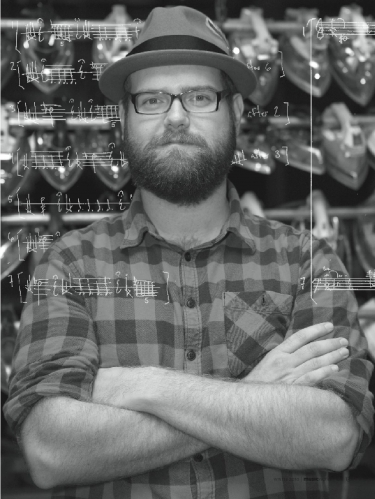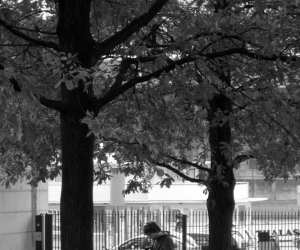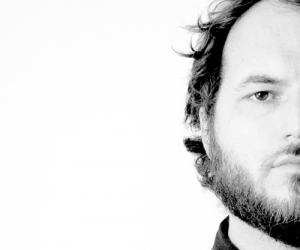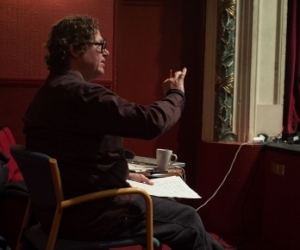
It’s 1999. The millennium is approaching, and Kyle Brenders, teenage saxophonist, is living the small-town Ontario version of the jazz life. He’s a member of the Bill Sherry Big Band, playing vintage swing tunes for dancers in the St. Thomas municipal arena, decades-old tunes echoing around the rafters. Brenders, who will ten years later joke that he “brought the average age of the band down to sixty-five,” relishes the camaraderie of senior musicians and the “really great experience of reading tons of charts,” many of them by Eddie Graf, the dean of Canadian dance band arrangers.
Jump ahead a decade and Brenders is leading a quartet in the close quarters of the front bar at the Tranzac, the Toronto Australia New Zealand Club, which has become one of the city’s regular venues for leading-edge music. In the midst of a collective improvisation, Brenders is something to hear, his saxophone the conduit of a mercurial mind, sounds emerging in a rapid sputter, odd interval leaps and plosives executed on the reed shifting suddenly to fluid lines, his tone rapidly mutating from the sweetness of classical saxophone timbre to the guttural asides and vocal interjections of the jazz tradition and on to the multiphonics that are increasingly the distinct vocabulary of the saxophone in free improvisation.
Since 2007, Brenders has been a central figure in the improvising music community in Toronto—as composer, saxophonist, and organizer, whether contributing to other people’s projects or leading his own diverse groups. Brenders’ combination of thought and action has made him a central figure. He’s released a challenging CD of solo saxophone music called Flows and Intensities, and a duet CD with Anthony Braxton where he clearly displays both the empathy of his playing and his ability to create his own paths. He has acted as artistic director for the AIM Toronto orchestra, putting together performances that featured Braxton, as well as performances of Oakland composer-percussionist Gino Robair’s improvised opera I, Norton. He’s also composed for the AIMT orchestra and is looking forward to a CD release of that music in early 2011. He regularly leads the Kyle Brenders Quartet, which includes trombonist Steve Ward, bassist Tomas Bouda, and drummer Mark Segger, and which is currently exploring Brenders’ one-sheet compositions. Additionally, he heads up the Kyle Brenders Ensemble, which recently released a CD of the extended Ways that testifies to his compelling voice as a composer.
Brenders is candid about one misstep in what seems to have been a smooth and rapid musical evolution from these early days in St. Thomas. In 2000 he spent an unsatisfying year in Toronto’s Humber College jazz program, where, despite his being inspired by the saxophone technique of mainstream musicians like Alex Dean, he was ultimately frustrated by what he viewed as the technocratic atmosphere of the school in general. For a while he even thought about leaving music, but then found a much more hospitable environment at Wilfred Laurier University, in Waterloo.
“After my audition, I had a meeting with Glenn Buhr, and he told me about the Improvisation Concerts Ensemble that he had started that year, and I was hooked. The idea of improvising freely was always there for me, but to have a university ensemble devoted to it was at the time very enlightened. And it proved to be a life-changing experience. Along with Peter Hatch’s first-year composition class, it led me towards the music I’m making now.”
Hatch was a significant influence, from introducing Brenders to Anthony Braxton’s music to giving him the phone number of David Mott, which led to Brenders taking private lessons with the Toronto saxophone virtuoso. “Most of our time was spent on developing sound and vocabulary. These weren’t regular lessons, but were frequent enough to have a profound effect. In one lesson, David played me Steve Lacy, Evan Parker, and Ned Rothenberg—stuff I had never heard before.”
Brenders’ thesis composition was performed by the Wilfred Laurier Orchestra and played in a reading by the Windsor Symphony. That experience coloured his views on composing. “At the time I needed to accomplish these pieces to get a sense of the discipline of writing for such a large group. However, I was generally disappointed with the results. I realized that this wasn’t an issue of improvisation or composition but was in fact an issue of the power of the performer ensemble. An orchestra carries with it a weight that is defined by the performers. That’s almost impossible to change. It’s an old institution, one that’s not interested in what I’m interested in—an equalization of musical relationships.”
Another experience in 2005 cemented Brenders’ place on the creative edges. Attending the inaugural session of the Vancouver Creative Music Institute, he worked with musicians who encouraged a personal creative approach: Evan Parker, Nicole Mitchell, François Houle, George Lewis, and Mark Dresser, among others.
That prefigured Brenders’ move to Wesleyan University in Middletown, Connecticut, a major centre for experimental music. The move afforded him a chance to work closely with Alvin Lucier and Anthony Braxton. “What I saw with Braxton was the way his music needs both the abilities of an accomplished reader of notation as well as an understanding of working in real time. This is something that I have always been interested in within my own music and I saw how well it worked with his. I became disinterested in having to write music that suited the performer. I wanted to be able to write whatever I felt like writing, and have a group that would be able to play it. To do this I’ve needed to find musicians to play with who are able to read incredibly difficult notation but are also able to make creative decisions about articulation, dynamics, etc., during performance. I’m not interested in having exact performances of pieces each time they are played. The most interesting music to me is music that is mutable, music that can change over time, music that is living.”
Braxton’s influence is apparent in a quote that Brenders uses as an e-mail tag-line: “The world of music is not owned by any one ethnic group or any particular idiom; music comes in every form and shape and affirms composite human reality.” It’s a key to Brenders’ own music and thought, with its shifting emphasis on spontaneous improvisation and subtle composed permutation, on the complexity and affirmation of the musical relationship.
Brenders has developed rapidly, and his work is increasingly distinct, at times undermining the hierarchy of style and the idea that mimicry can constitute any kind of success for the composer. “I enjoy music that lies in the cracks, music that is not easily defined by genre and style. The music I make reflects panstylistic or polystylistic interests in listening. At least I’d like to hope so. When I write a piece that reflects a particular style, it is also an exercise for me to see about composing in that style. It usually doesn’t come out the way the style is expected to, and that’s because I encourage the strangeness of my own approach to things, I don’t shy away from writing something that feels a little off.”
Brenders methodological reach is broad, with “the amount of control over notated material going from open or no notation to complex notation.” Sound, texture, and interaction are all important in his work, and he’s concerned with the joint claims of systems and inspiration, one flowing into another in his thought as well as his music. “Systems are very important to my compositions—setting one up and working within it, changing the system to suit my own intuition. The development of a piece comes from a single thought that then gets developed over time, whether this comes from a saxophone sound, or a violin technique, or a number sequence found in the tile of a subway wall, or the ability to hear sounds over time—the memory of motive through thematic transformation—or from an interest in duration, or from a rhythmic structure, or counterpoint and harmonic motion . . . it all usually germinates in my head for a while and then gets written down in some form or other and then worked on. Who I play with also informs the composition.”
“My method formed through my time at Wesleyan, where I really needed to address what my music was. I realized I didn’t need to struggle or justify my music to anyone. I realized I could do anything with music. The problem was what did I want to do? I found myself defining the aspects of the music that I wanted to control and those that I wanted to be free, and the continuum that lies between these.”
“The first piece that did this was called follow line flow line follow. It started as a piece for nine players that was ten pages long and then ended up being a piece for mutable ensemble, from duo to eighteen-piece orchestra, with fifty pages of notated material. It allowed me to develop ways of layering different styles of notation on the page that at the same time allowed for various levels of freedom and control over how the performer read the notation. This continued with Ways, which developed the idea of thematic development.”
“As I wrote Ways I was beginning to write short, one-page pieces that isolated aspects of music that I was interested in exploring. These pieces allow for much greater freedom for the performers—improvisationally, within the structure of the piece—yet at the same time are more accessible to a listener because the material is much more discrete.” Among these recent short works, pond stands out for its synthesis of elements, combining the tonal purity of Steve Ward’s classical trombone sound with a melody that permutates in a style influenced by Alvin Lucier.
At the end of our discussion, conducted in conversation and over e-mail, Brenders touched again on the inspiration of Braxton’s expansive and egalitarian thought. “If,” he observed, “we, as a society, were a little more sympathetic to Braxton’s ideals, it might change the structure of the music industry and, on a deeper level, the ability of people to experiment with music. Maybe this is a lofty and idealistic way to look at the world, but why not look at the world idealistically when it comes to creativity? If I felt that there was no place to go, then I would stop doing what I’m doing. But that’s not true. Music affirms my reality and whatever shape and form it comes out in is one that is important to my work and the work of people around me.”
Audio: pond (Excerpt, 2009). Composed by Kyle Brenders. Performed by Kyle Brenders, bass clarinet; Steve Ward, trombone; Tomas Bouda, contrabass; Mark Segger, percussion. Image: Kyle Brenders. Image by: Adam Coish. Image designed by: Lucinda Wallace.


